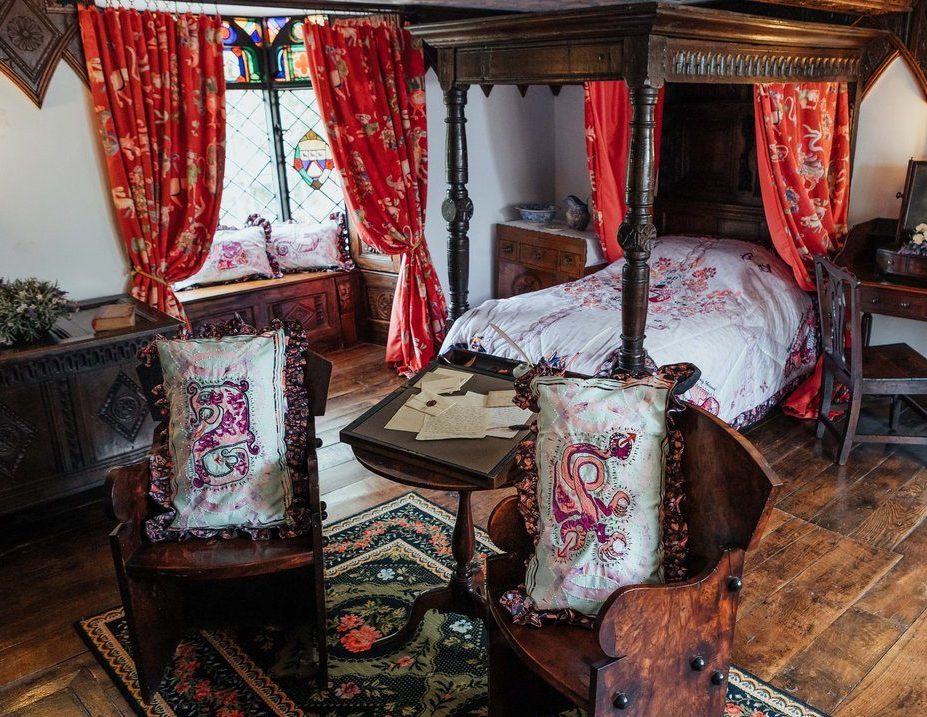
Queering Plas Newydd historic house through textile art – by Sarah-Joy Ford

For my Researcher-Led placement project, I partnered with Plas Newydd Historic House and Gardens to undertake an artist residency, where I would produce new artworks for a site-specific installation. The exhibition was the first of its kind to take place inside the house, making a queer intervention into the bedrooms of the house through my textile practice and quilting.
Plas Newydd was home to Lady Eleanor Butler (1739–1829) and Sarah Ponsonby (1755–1831), who captured the imagination of Regency society when they eloped from their families in Ireland to begin a life of exquisite retirement together, escaping the confines of their gendered fates of marriage and the convent. Over the years, they transformed Plas Newydd into a cottage orné.
The site specific exhibition involved a radical re-designing of the domestic textiles of the home including quilts, cushions and curtains. The new works were a loving intervention, and embroidered embellishment of this extraordinary tale of women who lived and loved differently, despite enormous societal restrictions.
One of the highlights of the project was working with Father Lee Taylor Collen’s church, where the three Ladies of Llangollen are buried. I organised an LGBTQ crafting workshop in the St Collen’s community hall, where we created mini banners inspired by the Ladies of Llangollen and their importance to LGBTQ history and identity.
To launch the exhibition, I organised a symposium that was held at the historic Hand Hotel. There were talks from Professor Alison Oram on the relationship between LGBTQ visitors and the house; Dr Freya Gowlrey on the importance of gift giving economies for the ladies; as well as performances from Jane Hoy from Aberrations. Jane even produced invitation cards for audience members to attend the private view at the house later in the evening. As part of the day, we also visited St Collen’s church for a tour from local archaeologist Sue Evans. To finish the day we had tours of the newly opened exhibition and a chance to discuss and celebrate the new work.
The residency gave me the opportunity to make artworks that were intimately entangled with the space of the house. Through textiles I was able to tenderly examine, pulling at the threads of the love between two women beloved to one another and centre their intimacy in the house once more. It was such a profound experience being able to make work in direct relationship to a historic house that has played such an important role in lesbian history. This project has allowed me to expand and extend the work undertaken through the PhD, establishing a methodology for a professional quilting and artistic practice that is deeply site-specific, enmeshed in archival research and extended through community engagement. This new area for practice-based research has challenged and inspired me whilst re-invigorated my practice, and I look forward to build on this experience to undertake further exciting work in collaboration with the heritage sector.
Sarah-Joy Ford is completing her PhD in Design at Manchester Metropolitan University. Sarah-Joy is an Artist and Associate Lecturer at Manchester School of Art. She works with textiles to explore the complexities and pleasures of queer communities, histories and archives. Her practice sits at intersection of digital and traditional: using strategies of quilting, digital embroidery, digital print, applique and hand embellishment.
Read the full story and watch a documentary on Sarah-Joy’s placement here.
For information on the NWCDTP Placement Scheme and the Researcher-Led strand and how to apply, see here. We offer 1-2-1 coaching sessions to help you develop your desired placement project.

0 Comments